
The 3DO Interactive Multiplayer, also referred to as simply 3DO, is a home video game console developed by The 3DO Company. Conceived by entrepreneur and Electronic Arts founder Trip Hawkins, the 3DO was not a console manufactured by the company itself, but a set of specifications, originally designed by Dave Needle and RJ Mical of New Technologies Group, that could be licensed by third parties. Panasonic produced the first models in 1993, and further renditions of the hardware were released afterwards by GoldStar, Sanyo, Creative Labs, and Samsung Electronics in 1997.
1993 saw many sequels and prequels in video games, such as Dragon Ball Z: Super Butōden, Mortal Kombat II, Secret of Mana, and Super Street Fighter II, alongside new titles such as Star Fox, FIFA International Soccer, Doom, Gunstar Heroes, Myst, Samurai Shodown, Ridge Racer, NBA Jam, Disney's Aladdin, and Virtua Fighter.
1991 saw many sequels and prequels in video games, such as Street Fighter II, Final Fantasy IV, Super Castlevania IV, Mega Man 4, Super Ghouls 'n Ghosts, and The Legend of Zelda: A Link to the Past, along with new titles such as Sonic the Hedgehog, Battletoads, Lemmings, Sunset Riders, Duke Nukem, Fatal Fury: King of Fighters, and Streets of Rage. The year's highest-grossing video game worldwide was Capcom's arcade fighting game Street Fighter II. The year's best-selling system was the Game Boy for the second year in a row, while the year's best-selling home video game was Sega's Sonic the Hedgehog, which was also the year's top video game rental in the United States.
1986 saw many sequels and prequels in video games, such as Super Mario Bros. 2, along with new titles such as Arkanoid, Bubble Bobble, Castlevania, Dragon Quest, Ikari Warriors, The Legend of Zelda, Metroid, Out Run and R.B.I. Baseball. The year's highest-grossing arcade video games were Hang-On in Japan, Hang-On and Gauntlet in the United States, and Nemesis (Gradius) in London. The year's best‑selling home system was the Nintendo Entertainment System (Famicom) for the third year in a row, while the year's best-selling home video games in Western markets were Super Mario Bros. in the United States and Yie Ar Kung-Fu in the United Kingdom.

Numerous video games based on the Jurassic Park franchise have been released. Developers Ocean Software, BlueSky Software and Sega produced various games in 1993, coinciding with the first film, Jurassic Park. In 1997, several developers, including DreamWorks Interactive and Appaloosa Interactive, produced various games for nine different platforms to coincide with the release of the film The Lost World: Jurassic Park.

The Horde is a hybrid action-strategy video game that was originally released for the 3DO Interactive Multiplayer and was ported to the Sega Saturn and DOS. It also featured full-motion video sequences featuring a number of actors including Kirk Cameron as Chauncey and Michael Gregory as Kronus Maelor. Video sequences were reduced to slide shows in some versions.

Crash 'N Burn is a futuristic racing/shooter video game developed by Crystal Dynamics and released for the 3DO in 1993. The game was the launch title for the system and was included as a pack-in game with Panasonic's original 3DO console.
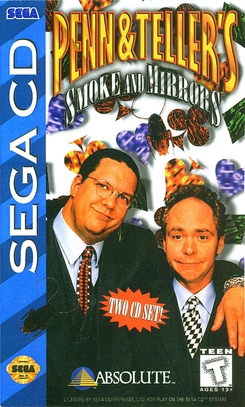
Penn & Teller's Smoke and Mirrors is a canceled minigame compilation developed by Absolute Entertainment and starring the magician duo Penn & Teller. It comprises six minigames used to play practical jokes on others: Two party tricks, two multiplayer "scams" in which one player can unfairly influence or interrupt the gameplay, the beat 'em up Smoke and Mirrors, and Desert Bus, in which the player must drive a bus over an empty, straight road for eight hours to score one point. Penn & Teller designed the game alongside Barry Marx, while Eddie Gorodetsky provided the concept for Desert Bus. The compilation was announced in 1994 for a release at the end of the year, which was later rescheduled for April Fools' Day 1995. Although the Sega CD version was finished on time and review copies were soon sent out, the financially stricken Absolute Entertainment could not afford to ship the game.

Starblade is a 1991 3D rail shooter arcade game developed and published by Namco. Controlling the starfighter FX-01 "GeoSword" from a first-person perspective, the player is tasked with eliminating the Unknown Intelligent Mechanized Species (UIMS) before they wipe out Earth. Gameplay involves controlling a crosshair with a flight yoke stick and destroying enemies and their projectiles before they inflict damage on the player.
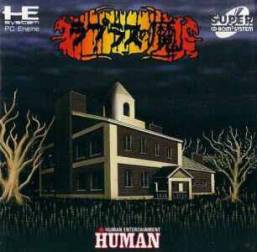
Laplace no Ma is a Japanese video game released in 1987 for the NEC PC-8801 and NEC PC-9801. The game was also ported to Sharp X68000, MSX, the SNES and TurboGrafx-CD. It is part of the Ghost Hunter dungeon crawler series, which also includes Kurokishi no Kamen for the 3DO and Paracelsus no Maken for the NEC PC.

Cyberwar is a DOS game based on the film The Lawnmower Man and a direct sequel to the video game adaptation of the film, which itself takes place after the film. It was released in 1994 by SCi. Ports were announced for the Sega CD, 3DO Interactive Multiplayer, and in Japan only for the Sega Saturn and Sony PlayStation, but only the PlayStation version was released.

Takeru: Letter of the Law is a video game based on the manga series by Buichi Terasawa. It was originally released by Matsushita Electric Industrial for the 3DO Interactive Multiplayer only in Japan as Terasawa Buichi no Takeru (寺沢武一の武), before being converted to the Microsoft Windows and Mac OS computer systems and published internationally Takeru: Letter of the Law and Buichi Terasawa's Takeru in 1996. The manga was published in English in 1992-1993 as Takeru - The Bad Boy of Yamato.

Total Eclipse is a space flight simulation video game developed and published by Crystal Dynamics for 3DO. It was later ported to the PlayStation under the title Total Eclipse Turbo. The game was copyrighted in 1993 and released 1994. Total Eclipse Turbo was a launch title for the PlayStation in the U.S., with the game's released date predating the North American console launch by 11 days. A sequel, Solar Eclipse, was released for Sega Saturn and PlayStation.

Samurai Shodown, known in Japan as Samurai Spirits, is a fighting game developed and published by SNK for the Neo Geo arcade and home platform. Released in 1993, it is the first installment in the Samurai Shodown series. In contrast to other fighting games at the time, which were set in modern times and focused primarily on hand-to-hand combat, Samurai Shodown is set in feudal-era Japan and was SNK's first arcade fighting game to focus primarily on weapon-based combat.
The Life Stage: Virtual House is a construction simulation/adventure game developed by Microcabin for the 3DO Interactive Multiplayer. The player is given tools to create virtual living spaces and may also view several predesigned virtual homes. The Life Stage: Virtual House was a launch title for the 3DO in Japan.

Universal Interactive was an American video game publisher. The company was established on January 4, 1994, and led by Skip Paul and Robert Biniaz of MCA. It was best known for producing the Crash Bandicoot and Spyro platform game franchises.
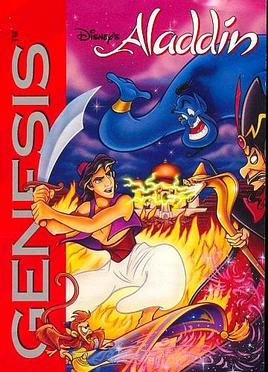
Disney's Aladdin is a platform game based on the 1992 film of the same name developed by Virgin Games USA. The game was released by Sega for the Sega Genesis on November 11, 1993 as one of several games based on the film, including another game that was released in the same month by Capcom for the Super NES.
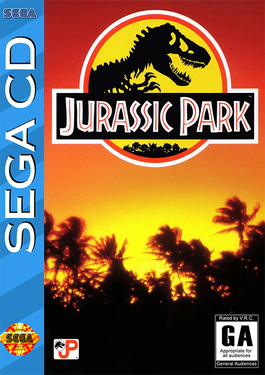
Jurassic Park is a 1994 point-and-click adventure game developed and published by Sega for the Sega CD. The video game is based on the 1993 film of the same name, and includes elements from Michael Crichton's 1990 novel Jurassic Park, which the film is based upon.

Road Rash is a 1994 racing and vehicular combat video game originally published by Electronic Arts (EA) for the 3DO Interactive Multiplayer. A version for the Sega CD was developed simultaneously and released in 1995 to act as a "bridge" between the 3DO version and the Sega Genesis title Road Rash 3, and the game was subsequently ported to the PlayStation, Sega Saturn, and Microsoft Windows in 1996. The game is the third installment in the Road Rash series, and is centered around a series of motorcycle races throughout California that the player must win to advance to higher-difficulty races, while engaging in unarmed and armed combat to hinder the other racers.
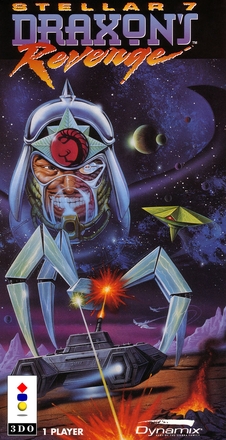
Stellar 7: Draxon's Revenge is a 1993 video game developed and published by Dynamix for the 3DO Interactive Multiplayer.
















